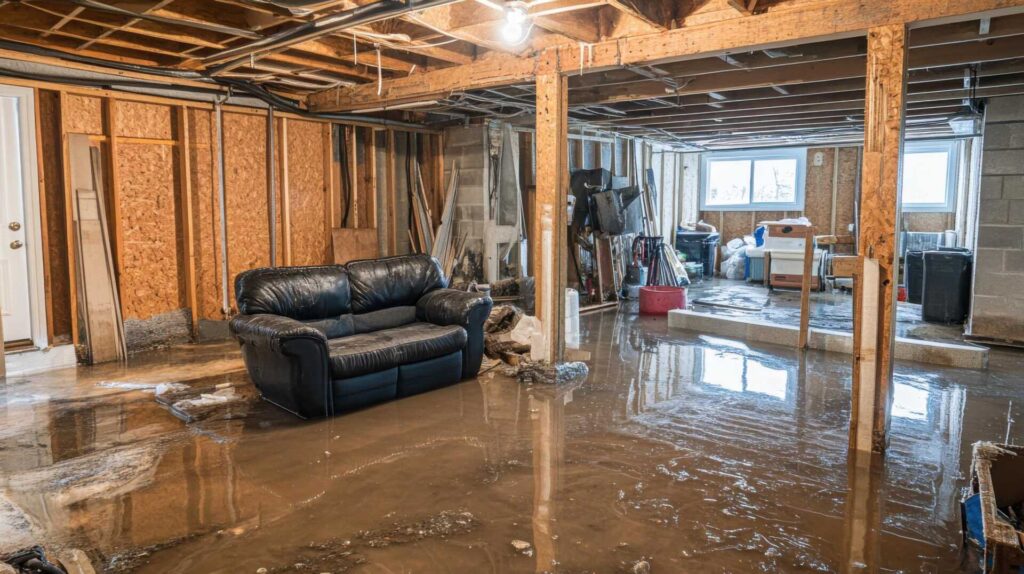
Contents
Flood damage in your basement needs to be addressed promptly and effectively to prevent further complications. You’ll want to evaluate the extent of the damage and take swift action. From water extraction to mold prevention, several key techniques can help restore your space. Understanding these methods can make all the difference in protecting your home and ensuring a safe environment. What are the specific steps you should consider?
Key Takeaways
- Assess the extent of water damage using moisture detection tools and inspect for mold growth or structural integrity issues.
- Employ sump pumps for efficient removal of standing water, placing them in the lowest areas for optimal performance.
- Improve ventilation by opening windows and using fans, while utilizing dehumidifiers to maintain humidity below 60%.
- Act promptly on any signs of mold by cleaning affected areas and using appropriate mold removal techniques.
- Repair structural damage by reinforcing foundations, replacing affected materials, and enhancing drainage systems to prevent future flooding.
Assessing the Extent of Water Damage
When you encounter water damage in your basement, it’s essential to assess the extent of the problem quickly.
Start by conducting a thorough damage assessment to identify affected areas, including walls, floors, and any stored items. Use moisture detection tools, like hygrometers or moisture meters, to measure humidity levels and pinpoint hidden moisture. This can reveal underlying issues that mightn’t be visible at first glance.
Look for signs of mold growth, discoloration, or warping, as these can indicate prolonged exposure to water.
Also, check for structural integrity; soft spots might suggest severe damage. Document your findings, as this information will be invaluable for insurance claims or professional help.
Remember, the sooner you assess the damage, the more effectively you can address it, preventing further complications.
Water Extraction Methods
Effective water extraction methods are crucial in minimizing damage after a flood. One of the most reliable solutions is using a sump pump, which efficiently removes standing water from your basement.
You’ll want to place the sump pump in the lowest area of your basement to ensure peak performance. If your property has existing drainage systems, these can greatly enhance water removal by directing excess water away from your home.
For smaller areas, consider using wet/dry vacuums, which are effective for extracting water from carpets and hard-to-reach places.
Remember to check the capacity of your equipment; you may need multiple pumps or vacuums for larger volumes of water.
In all cases, act quickly to prevent mold growth and structural damage. By employing these water extraction methods, you can safeguard your home and create a smoother restoration process.
Drying and Dehumidification Techniques
After successfully extracting water from your basement, the next step is to focus on drying and dehumidification techniques to prevent further damage.
Start by improving ventilation methods; open windows and use fans to create airflow, helping moisture evaporate more quickly. If outdoor conditions aren’t favorable, consider using high-velocity air movers to circulate air in confined spaces.
In addition to ventilation, invest in dehumidifiers. These devices are essential for moisture control, as they pull excess water vapor from the air, greatly speeding up the drying process.
Aim to maintain indoor humidity levels below 60% to inhibit mold growth and structural damage.
Monitor the drying progress with moisture meters, ensuring that all affected areas, including walls and floors, reach appropriate dryness levels.
Mold Prevention and Remediation
To prevent mold growth in your basement, it’s essential to address moisture issues promptly and thoroughly.
Start by ensuring proper ventilation; use exhaust fans or open windows to reduce humidity. Regularly inspect for leaks or water intrusion, as early mold detection can save you time and money. If you notice signs of mold, act quickly—mold removal is most effective when caught early.
You can use a solution of vinegar or a commercial mold remover for small areas, but for extensive mold infestations, consider hiring a professional. They’ve the right tools and expertise to handle the situation safely.
Additionally, maintaining a humidity level below 60% with dehumidifiers can greatly reduce the chances of mold growth.
Remember to clean and dry any water-damaged materials within 24-48 hours. By staying proactive about moisture control, you can keep your basement mold-free and ensure a healthy living environment.
Structural Repairs and Restoration
When dealing with basement flood damage, addressing structural repairs is essential to maintaining the integrity of your home. First, assess the extent of the damage. You might need foundation reinforcement to ensure stability, especially if the flood compromised structural integrity. This process often involves adding steel beams or piers to support weakened areas.
Next, consider wall insulation. Proper insulation protects against future water intrusion and helps maintain a stable indoor climate. You should replace any damaged insulation with moisture-resistant materials.
Here’s a quick overview of some common structural repairs:
| Repair Type | Description |
|---|---|
| Foundation Reinforcement | Strengthening the foundation with beams |
| Wall Insulation | Installing moisture-resistant insulation |
| Crack Sealing | Filling in cracks to prevent leaks |
| Flooring Replacement | Replacing damaged flooring materials |
| Drainage Improvement | Enhancing drainage systems to reduce water |
Wrap-Up
Addressing basement flood damage requires swift action and careful planning. By evaluating the extent of water damage, employing effective water extraction methods, utilizing drying and dehumidification techniques, prioritizing mold prevention and remediation, and making necessary structural repairs, you can restore your basement to a safe and functional space. Stay proactive, stay informed, and take control of your restoration process to ensure a dry, healthy environment for you and your family.
Recent Posts
Why Choose a 24/7 Emergency Water Extraction Service?
Water extraction is critical when you return home to find your basement flooded after a
Is Mold Removal After Water Damage Necessary?
When water damage occurs, it’s often just an unfortunate bump in the road for homeowners.
Top 5 Expert Mold Removal Tips After Water Damage
Did you know that mold can start growing within 24 to 48 hours after water
